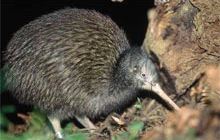Moehau monitoring reveals kiwi protection success
Archived content: This media release was accurate on the date of publication.
Introduction
Two decades of sustained predator control has seen the heartening growth of the kiwi population at Mt Moehau in northern Coromandel.Date: 31 March 2022
Moehau is an 892 m high mountain, and the highest peak in the Coromandel Peninsula. It is significant to mana whenua as a final resting place for chiefs and is a known habitat for the Coromandel brown kiwi.
The Department of Conservation’s (DOC) Coromandel Operations Manager Nick Kelly says Moehau has been the focus of more than 20 years of predator trapping by both DOC and community conservation organisation Moehau Environment Group. Trapping has been supplemented with periodic aerial 1080 operations run by DOC to control possums – operations which also kill resident stoats that avoid going into traps.
“We’ve got some very encouraging initial results in from monitoring undertaken between July and October 2021,” Nick Kelly says.
“Monitoring was undertaken at 78 different sites, with two hours spent at each site over three different nights. Of those 78 sites, 76 of them were also part of surveys in 2000 and 2009,” he says.
The most recent results show 489 kiwi detected in the monitoring on and around Moehau – up from 131 detected birds in 2000 (when monitoring began) and 264 birds in 2009. In the 2021 count, 325 birds were male and 164 were female. This apparent imbalance in sex ratio is not too surprising given males call more often than females, and so most of these males probably have a partner.
Male kiwi have a different call tone to females, more high-pitched, which is how the listener can determine the gender of the birds they’re hearing.
The monitoring also showed kiwi detected at 99% of monitoring points rather than the 65% in 2000 – good evidence the population around the mountain is expanding, Nick Kelly says.
Monitoring was undertaken by experienced kiwi monitoring professional Paddy Stewart of Red Admiral Ecology and his colleagues, who identified the location and distance of the birds from widely spaced monitoring points in a plotted area.
Human listeners record information about each kiwi call heard, with the information analysed at a later date. The human ear is considered better at detecting kiwi calls than automated recording devices, and a person can also work out the direction the calls are coming from and hence the number of different individuals – something automated recorders can not yet do.
“What we’re seeing here is how continued control and suppression of predators like possums and stoats can help our taonga species,” Nick Kelly says.
“More than 20 years of hard work protecting the Coromandel brown kiwi is paying off with more birds in the bush.”
Moehau Environment Group chair Letticia Williams welcomed the news of a growing population of kiwi around the mountain.
“This is an excellent result, and it reflects the consistent effort put in by volunteers, landowners and trappers,” she says.
“The increase in kiwi numbers is huge reward for all those ‘hard yards’ that are put in month in, and month out. It’s well worth celebrating.”
Contact
For media enquiries contact:
Email: media@doc.govt.nz

